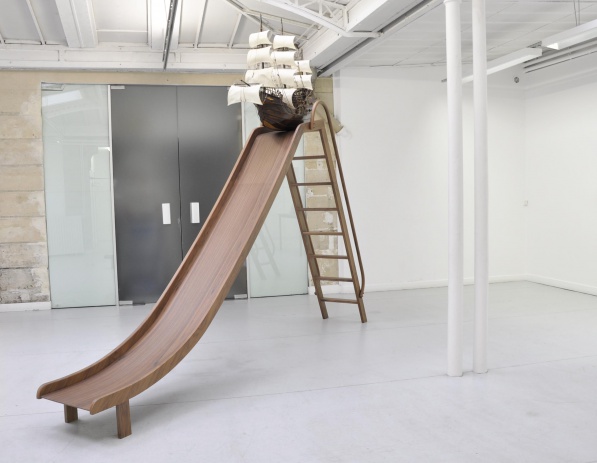Céline Cléron
L'horizon des événementsfrom May 20 to July 13 - 2017
print
Céline CLÉRON
The event horizon
20 May – 13 July, 2017
Opening on Saturday 20 May, 12 p.m. – 8:30 p.m.
During CHOICES Paris Gallery Weekend, the gallery will exceptionally be open on Sunday 21 May from 12 p.m. to 7 p.m.
In astrophysics, the event horizon is the limit where light starts being absorbed by a black hole. In these remarkable areas of the cosmos, the space-time dilates under the effect of colossal gravitational forces. Céline Cléron recognizes an aspect of her art in this suspension of time. Her sculpture Une minute de latitude, for instance, shows a sailboat suspended at the top of a slide, on the verge of slipping into the abyss.
For her first exhibition at the Galerie Papillon in Paris, the artist crystallizes this vertiginous horizon through a collection of new and recent works dealing with gravitation, wave mechanics, points of balance, fun fairs, myths, risk and death. These creations form a composite landscape of bone and wood populated with animal skeletons, roller-coasters, ruins and ghostly portraits; all of this in the presence of humans who are very much alive: us spectators. Very much alive indeed, but for how much longer ?
This horizon is spotted with the breaking points with which our civilization is currently gambling. This is precisely what the artist denounces in the series of sculptures entitled Conseil de révision, consisting in stadiometers made with mammal or fish skulls that cap the human beings under them. Our backs to the wall as we face our own contradictions, we are put back in the place we actually occupy in the living world. Through this evocation of the evolution of species and the relationship between man and animal, our whole contemporary experience is summoned: a paradoxical and vertiginous experience, which feels like a rollercoaster ride. And in a way, it is exorcized.
The art of Céline Cléron is somewhat solemn but also playful. This is why the horizon she offers in this exhibition aims at frustrating the inclinations to catastrophism that surround us. Its deep nature, its focal point, corresponds above all to a visionary horizon that encourages us to subvert, go beyond and transcend.
Go beyond the tensions between the forces that inhabit this world, which are re-articulated in the exhibition with, on one side, verticality, structure, reason, the necessity to rigidify and constrain and, on the other, horizontality, curves, movement, and the need to escape and take risks.
Taking the risk to see, in fact. Let us not forget that, in cosmography, an event horizon also suggests the existence of a form of “world beyond”. A universe beyond the universe on which scientists are currently speculating: are black holes points of no return, bottomless or endless abysses ? Or are they gateways to other worlds, other realities of space-time to which they could give us access, through time travel for instance ?
These temporal transitions evoke some of Céline Cléron’s works, works that take us to other periods of the history of art, which the artist revisits by making them come up to the surface of the present. In this case, for instance, with the resurgence of the fascinating Fayum mummy portraits, excavated from tombs dating from Roman Egypt, with their fixed eyes that seem to contemplate us from beyond. In the exhibition, they regain an unsettling presence through a new series of sculptures made of glass and sand inspired by them.
Most of the apparition-images that Céline Cléron summons in her art (unless she is summoned by them?) come from strange daydreams or bizarre, generally unexpected visions, which impose themselves on the artist before she materializes them in her sculptures or watercolours.
These vision-images, which the artist receives before transmitting them to us, evoke the mysteries of the oracular dimension. This is also symbolized by the great python skeleton in the sculpture bearing the same name as the exhibition (L’horizon des événements #2/The event horizon #2). The python also gave its name to the famous Oracle of Delphi, the Pythia, who delivered her messages from the bottom of a cave, perched on a tripod, on the edge of an abyss.
In the present case, the cave is of course the exhibition where Céline Cléron invites us to stand on the edge of the world to reconsider the oracle-artwork as a key and possible resolution. As a form of hope, too, since here, the event horizon becomes a visionary horizon to which works of art give access again.
Pascal Pique